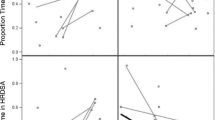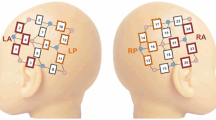Abstract
We investigated heart rate (HR) in infants at 3, 6, 9, and 12 months of age, at high (HRA) and low (LRC) familial risk for ASD, to identify potential endophenotypes of ASD risk related to attentional responses. HR was extracted from functional near-infrared spectroscopy recordings while infants listened to speech stimuli. Longitudinal analysis revealed that HRA infants and males generally had lower baseline HR than LRC infants and females. HRA infants showed decreased HR responses to early trials over development, while LRC infants showed increased responses. These findings suggest altered developmental trajectories in physiological responses to speech stimuli over the first year of life, with HRA infants showing less social orienting over time.




Similar content being viewed by others
Notes
To rule out the possibility that confounding cognitive factors may explain any findings of differing psychological arousal to speech stimuli in HRA infants, we examined available Mullen data, and found that neither verbal nor non-verbal developmental quotients (DQ) were significantly different between HRA and LRC infants (p (verbal DQ, 6 months) = 0.57, p (verbal DQ, 12 months) = 0.22, p (non-verbal DQ, 6 months) = 0.69, p (non-verbal DQ, 12 months) = 0.36) or males and females (p (verbal DQ, 6 months) = 0.71, p (verbal DQ, 12 months) = 0.18, p (non-verbal DQ, 6 months) = 0.92, p (non-verbal DQ, 12 months) = 0.12; see Table 1).
At the time of this manuscript such analyses are not possible (models including gender did not converge) as of the 66 infants who have completed the study and received final clinical judgments, only three females had received an ASD diagnosis.
References
American Psychiatric Association. (2013). Diagnostic and statistical manual of mental disorders (DSM-5 ® ). Washington, D.C.: American Psyciatric Association. doi:10.1002/gps.
Aslin, R. N. (2007). What’s in a look? Developmental Science, 10(1), 48–53. doi:10.1111/j.1467-7687.2007.00563.x.
Baio, J. (2014). Prevalence of autism spectrum disorder among children aged 8 years—Autism and developmental disabilities monitoring network, 11 sites, United States, 2010. Center for Disease Control and Prevention Surveillance Summaries, 63(2), 1–24.
Bal, E., Harden, E., Lamb, D., Van Hecke, A. V., Denver, J. W., & Porges, S. W. (2010). Emotion recognition in children with autism spectrum disorders: relations to eye gaze and autonomic state. Journal of Autism and Developmental Disorders, 40(3), 358–370. doi:10.1007/s10803-009-0884-3.
Chevallier, C., Kohls, G., Troiani, V., Brodkin, E. S., & Schultz, R. T. (2012). The social motivation theory of autism. Trends in Cognitive Sciences, 16(4), 231–239. doi:10.1016/j.tics.2012.02.007.
Cohen, D. J., & Johnson, W. T. (1977). Cardiovascular correlates of attention in normal and psychiatrically disturbed children. Blood pressure, peripheral blood flow, and peripheral vascular resistance. Archives of General Psychiatry, 34(5), 561–567.
Corona, R., Dissanayake, C., Arbelle, S., Wellington, P., & Sigman, M. (1998). Is affect aversive to young children with autism? Behavioral and cardiac responses to experimenter distress. Child Development, 69(6), 1494–1502.
Courage, M. L., Reynolds, G. D., & Richards, J. E. (2006). Infants’ attention to patterned stimuli: Developmental change from 3 to 12 months of age. Child Development, 77(3), 680–695. doi:10.1111/j.1467-8624.2006.00897.x.
Daluwatte, C., Miles, J. H., Christ, S. E., Beversdorf, D. Q., Takahashi, T. N., & Yao, G. (2013). Atypical pupillary light reflex and heart rate variability in children with autism spectrum disorder. Journal of Autism and Developmental Disorders, 43(8), 1910–1925. doi:10.1007/s10803-012-1741-3.
Fracasso, M. P., Porges, S. W., & Lamb, M. E. (1994). Cardiac activity in infancy: Reliability and stability of individual differences. Infant Behavior and Development, 17(3), 277–284. doi:10.1016/0163-6383(94)90006-X.
Gervain, J., Macagno, F., Cogoi, S., Peña, M., & Mehler, J. (2008). The neonate brain detects speech structure. Proceedings of the National Academy of Sciences of the United States of America, 105(37), 14222–14227. doi:10.1073/pnas.0806530105.
Glotzbach, S. F., Edgar, D. M., Boeddiker, M., & Ariagno, R. L. (1994). Biological rhythmicity in normal infants during the first 3 months of life. Pediatrics, 94(4), 482–488.
Gottesman, I. I., & Gould, T. D. (2003). The endophenotype concept in psychiatry: etymology and strategic intentions. The American Journal of Psychiatry, 160(4), 636–645. doi:10.1176/appi.ajp.160.4.636.
Graham, F. K., & Jackson, J. C. (1970). Arousal systems and infant heart rate responses. Advances in Child Development and Behavior, 5, 59–117.
Graveling, R. A., & Brooke, J. D. (1978). Hormonal and cardiac response of autistic children to changes in environmental stimulation. Journal of Autism and Childhood Schizophrenia, 8(4), 441–455.
Holper, L., Seifritz, E., & Scholkmann, F. (2016). Short-term pulse rate variability is better characterized by functional near-infrared spectroscopy than by photoplethysmography. Journal of Biomedical Optics, 21(9), 91308–091308. doi:10.1117/1.JBO.21.9.091308.
Katona, P. G., Frasz, A., & Egbert, J. (1980). Maturation of cardiac control in full-term and preterm infants during sleep. Early Human Development, 4(2), 145–159.
Klin, A., Lin, D. J., Gorrindo, P., Ramsay, G., & Jones, W. (2009). Two-year-olds with autism orient to non-social contingencies rather than biological motion. Nature, 459(7244), 257–261. doi:10.1038/nature07868.
Kootz, J. P., & Cohen, D. J. (1981). Modulation of sensory intake in autistic children: cardiovascular and behavioral indices. Journal of the American Academy of Child Psychiatry, 20(4), 692–701.
Kushki, A., Brian, J., Dupuis, A., & Anagnostou, E. (2014). Functional autonomic nervous system profile in children with autism spectrum disorder. Molecular Autism, 5(1), 39. doi:10.1186/2040-2392-5-39.
Kushki, A., Drumm, E., Pla Mobarak, M., Tanel, N., Dupuis, A., Chau, T., & Anagnostou, E. (2013). Investigating the autonomic nervous system response to anxiety in children with autism spectrum disorders. PloS One, 8(4), e59730–e59710. doi:10.1371/journal.pone.0059730.
Lake, C. R., Ziegler, M. G., & Murphy, D. L. (1977). Increased norepinephrine levels and decreased dopamine-beta-hydroxylase activity in primary autism. Archives of General Psychiatry, 34(5), 553–556.
Levine, T. P., Sheinkopf, S. J., Pescosolido, M., Rodino, A., Elia, G., & Lester, B. (2012). Physiologic arousal to social stress in children with autism spectrum disorders: A pilot study. Research in Autism Spectrum Disorders, 6(1), 177–183. doi:10.1016/j.rasd.2011.04.003.
Lord, C., Rutter, M., Dilavore, P., & Risi, S. (2008). ADOS: Autism diagnostic observation schedule. Boston: Hogrefe.
Messinger, D. S., Young, G. S., Webb, S. J., Ozonoff, S., Bryson, S. E., Carter, A., et al. (2015). Early sex differences are not autism-specific: A baby siblings research consortium (BSRC) study. Frontiers in Psychology, 6(1), 1–12. doi:10.1186/s13229-015-0027-y.
Ming, X., Julu, P. O. O., Brimacombe, M., Connor, S., & Daniels, M. L. (2005). Reduced cardiac parasympathetic activity in children with autism. Brain & Development, 27(7), 509–516. doi:10.1016/j.braindev.2005.01.003.
Mrowka, R., Patzak, A., Schubert, E., & Persson, P. (1996). Linear and non-linear properties of heart rate in postnatal maturation. Cardiovascular research 31(3), 447–454.
Perdue, K. L., Westerlund, A., McCormick, S. A., & Nelson, C. A. III (2014). Extraction of heart rate from functional near-infrared spectroscopy in infants. Journal of Biomedical Optics, 19(6), 067010–067010. doi:10.1117/1.JBO.19.6.067010.
Pierce, K., Marinero, S., Hazin, R., McKenna, B., Barnes, C. C., & Malige, A. (2016). Eye tracking reveals abnormal visual preference for geometric images as an early biomarker of an autism spectrum disorder subtype associated with increased symptom severity. Biological Psychiatry, 79(8), 657–666. doi:10.1016/j.biopsych.2015.03.032.
Pinheiro, J., Bates, D., DebRoy, S., Sarkar, D., R Core Team. (2016). Linear and nonlinear mixed effects models [R package nlme version 3.1-128]. http://CRAN.R-project.org/package=nlme.
Porges, S. W., Macellaio, M., Stanfill, S. D., McCue, K., Lewis, G. F., Harden, E. R., et al. (2013). Respiratory sinus arrhythmia and auditory processing in autism: modifiable deficits of an integrated social engagement system? International Journal of Psychophysiology : Official Journal of the International Organization of Psychophysiology, 88(3), 261–270. doi:10.1016/j.ijpsycho.2012.11.009.
R Core Team. (2016). R: A Language and Environment for Statistical Computing. Vienna: R Core Team. https://www.R-project.org/.
Richards, J. E., & Cameron, D. (1989). Infant heart-rate variability and behavioral developmental status. Infant Behavior and Development, 12(1), 45–58. doi:10.1016/0163-6383(89)90052-0.
Richards, J. E., & Casey, B. J. (1991). Heart rate variability during attention phases in young infants. Psychophysiology, 28(1), 43–53. doi:10.1111/j.1469-8986.1991.tb03385.x.
Rutter, M., Bailey, A., & Lord, C. (2003). The Social Communication Questionnaire. Torrance, CA: Western Psychological Services.
Sigman, M., Dissanayake, C., Corona, R., & Espinosa, M. (2003). Social and cardiac responses of young children with autism. Autism : The International Journal of Research and Practice, 7(2), 205–216.
Silvetti, M. S., Drago, F., & Ragonese, P. (2001). Heart rate variability in healthy children and adolescents is partially related to age and gender. International Journal of Cardiology, 81(2–3), 169–174.
Tager-Flusberg, H. (2010). The origins of social impairments in autism spectrum disorder: Studies of infants at risk. Neural Networks : The Official Journal of the International Neural Network Society, 23(8–9), 1072–1076. doi:10.1016/j.neunet.2010.07.008.
Trajkovic, I., Scholkmann, F., & Wolf, M. (2011). Estimating and validating the interbeat intervals of the heart using near-infrared spectroscopy on the human forehead. Journal of Biomedical Optics, 16(8), 087002-087002-9. doi:10.1117/1.3606560.
Viding, E., & Blakemore, S.-J. (2007). Endophenotype approach to developmental psychopathology: implications for autism research. Behavior Genetics, 37(1), 51–60. doi:10.1007/s10519-006-9105-4.
Wagner, J. B., Fox, S. E., Tager-Flusberg, H., & Nelson, C. A. (2011). Neural processing of repetition and non-repetition grammars in 7-and 9-month-old infants. Frontiers in Psychology. doi:10.3389/fpsyg.2011.00168/abstract.
Watson, L. R., Roberts, J. E., Baranek, G. T., Mandulak, K. C., & Dalton, J. C. (2012). Behavioral and physiological responses to child-directed speech of children with autism spectrum disorders or typical development. Journal of Autism and Developmental Disorders, 42(8), 1616–1629. doi:10.1007/s10803-011-1401-z.
Werling, D. M., & Geschwind, D. H. (2015). Recurrence rates provide evidence for sex-differential, familial genetic liability for autism spectrum disorders in multiplex families and twins. Molecular Autism, 6(1), 63. doi:10.1186/s13229-015-0004-5.
Acknowledgments
We are extremely grateful to the families for their invaluable contribution to the Infant Sibling Project. We would also like to acknowledge the Infant Sibling Project staff—Tara Augenstein, Lauren Baczewski, Leah Casner, Kristin Concannon, Frances Cooley, Morgan Crossman, Kerri Downing, Mary Kate Driscoll, Sharon Fox, Linnea Joffe-Nelson, Kristina Joas, Brandon Keehn, Jack Keller, Nina Leezenbaum, Vanessa Loukas, Rhiannon Luyster, Stephanie Marshall, Sarah Mumanachit, Anne Seery, Meagan Thompson, Vanessa Vogel-Farley, Jennifer Wagner, and Anne-Marie Zuluaga—for their assistance in data acquisition and helpful advice.
Author Contributions
CAN, HTF conceived and designed the Infant Sibling Project. KLP, CAN designed the HR study. KLP, LAE analyzed data. KLP, LAE, CAN, HTF participated in the interpretation of the data. KLP, LAE drafted the manuscript. CAN, HTF critically revised the manuscript for important intellectual content. All authors read and approved the final manuscript.
Funding
This research was supported by National Institutes of Health Grant R01-DC010290 to Helen Tager-Flusberg and Charles A. Nelson and The Simons Foundation (137186) to Charles A. Nelson.
Author information
Authors and Affiliations
Corresponding author
Ethics declarations
Conflict of interest
Katherine L. Perdue, Laura A. Edwards, Helen Tager-Flusberg, and Charles A. Nelson declared that they have no conflict of interest.
Ethical Approval
All study procedures were monitored and approved by the Boston Children’s Hospital Institutional Review Board under IRB protocol X10-02-0083. All procedures performed in studies involving human participants were in accordance with the ethical standards of the institutional and/or national research committee and with the 1964 Helsinki declaration and its later amendments or comparable ethical standards. Informed consent was obtained from all individual participants included in the study. This article does not contain any studies with animals performed by any of the authors.
Rights and permissions
About this article
Cite this article
Perdue, K.L., Edwards, L.A., Tager-Flusberg, H. et al. Differing Developmental Trajectories in Heart Rate Responses to Speech Stimuli in Infants at High and Low Risk for Autism Spectrum Disorder. J Autism Dev Disord 47, 2434–2442 (2017). https://doi.org/10.1007/s10803-017-3167-4
Published:
Issue Date:
DOI: https://doi.org/10.1007/s10803-017-3167-4




